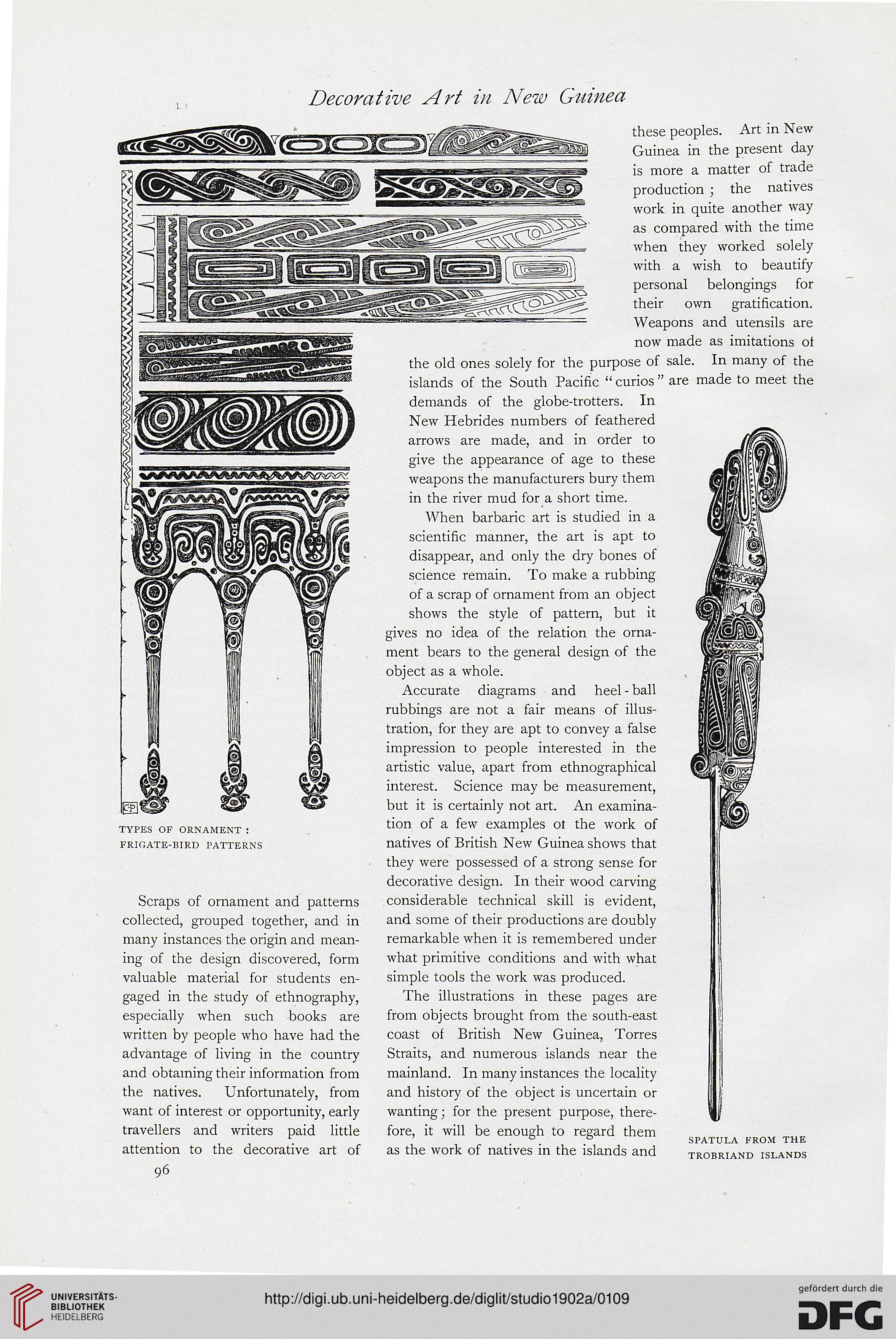Decorative Art in New Guinea
Wmm6
these peoples. Art in New
Guinea in the present day
is more a matter of trade
production ; the natives
work in quite another way
as compared with the time
when they worked solely
with a wish to beautify
personal belongings for
their own gratification.
Weapons and utensils are
now made as imitations ot
the old ones solely for the purpose of sale. In many of the
islands of the South Pacific " curios " are made to meet the
demands of the globe-trotters. In
New Hebrides numbers of feathered
arrows are made, and in order to
give the appearance of age to these
ySgg^ weapons the manufacturers bury them
in the river mud for a short time.
When barbaric art is studied in a
scientific manner, the art is apt to
disappear, and only the dry bones of
science remain. To make a rubbing
of a scrap of ornament from an object
shows the style of pattern, but it
gives no idea of the relation the orna-
ment bears to the general design of the
object as a whole.
Accurate diagrams and heel - ball
rubbings are not a fair means of illus-
tration, for they are apt to convey a false
impression to people interested in the
artistic value, apart from ethnographical
interest. Science may be measurement,
but it is certainly not art. An examina-
tion of a few examples ot the work of
frigate-bird patterns natives of British New Guinea shows that
they were possessed of a strong sense for
decorative design. In their wood carving
Scraps of ornament and patterns considerable technical skill is evident,
collected, grouped together, and in and some of their productions are doubly
many instances the origin and mean- remarkable when it is remembered under
ing of the design discovered, form what primitive conditions and with what
valuable material for students en- simple tools the work was produced,
gaged in the study of ethnography, The illustrations in these pages are
especially when such books are from objects brought from the south-east
written by people who have had the coast of British New Guinea, Torres
advantage of living in the country Straits, and numerous islands near the
and obtaining their information from mainland. In many instances the locality
the natives. Unfortunately, from and history of the object is uncertain or
want of interest or opportunity, early wanting ; for the present purpose, there-
travellers and writers paid little fore, it will be enough to regard them
attention to the decorative art of as the work of natives in the islands and
96
types of ornament :
I
spatula from the
trobriand islands
Wmm6
these peoples. Art in New
Guinea in the present day
is more a matter of trade
production ; the natives
work in quite another way
as compared with the time
when they worked solely
with a wish to beautify
personal belongings for
their own gratification.
Weapons and utensils are
now made as imitations ot
the old ones solely for the purpose of sale. In many of the
islands of the South Pacific " curios " are made to meet the
demands of the globe-trotters. In
New Hebrides numbers of feathered
arrows are made, and in order to
give the appearance of age to these
ySgg^ weapons the manufacturers bury them
in the river mud for a short time.
When barbaric art is studied in a
scientific manner, the art is apt to
disappear, and only the dry bones of
science remain. To make a rubbing
of a scrap of ornament from an object
shows the style of pattern, but it
gives no idea of the relation the orna-
ment bears to the general design of the
object as a whole.
Accurate diagrams and heel - ball
rubbings are not a fair means of illus-
tration, for they are apt to convey a false
impression to people interested in the
artistic value, apart from ethnographical
interest. Science may be measurement,
but it is certainly not art. An examina-
tion of a few examples ot the work of
frigate-bird patterns natives of British New Guinea shows that
they were possessed of a strong sense for
decorative design. In their wood carving
Scraps of ornament and patterns considerable technical skill is evident,
collected, grouped together, and in and some of their productions are doubly
many instances the origin and mean- remarkable when it is remembered under
ing of the design discovered, form what primitive conditions and with what
valuable material for students en- simple tools the work was produced,
gaged in the study of ethnography, The illustrations in these pages are
especially when such books are from objects brought from the south-east
written by people who have had the coast of British New Guinea, Torres
advantage of living in the country Straits, and numerous islands near the
and obtaining their information from mainland. In many instances the locality
the natives. Unfortunately, from and history of the object is uncertain or
want of interest or opportunity, early wanting ; for the present purpose, there-
travellers and writers paid little fore, it will be enough to regard them
attention to the decorative art of as the work of natives in the islands and
96
types of ornament :
I
spatula from the
trobriand islands




